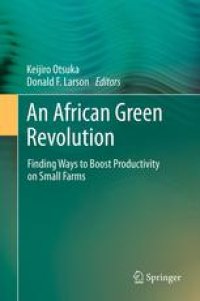
Ebook: An African Green Revolution: Finding Ways to Boost Productivity on Small Farms
Author: Keijiro Otsuka Donald F. Larson Peter B. R. Hazell (auth.) Keijiro Otsuka Donald F. Larson (eds.)
- Genre: Biology // Plants: Agriculture and Forestry
- Tags: Environmental Engineering/Biotechnology, Agricultural Economics, Economic Policy, Development Economics
- Year: 2013
- Publisher: Springer Netherlands
- Edition: 1
- Language: English
- pdf
This volume explores the usefulness of the Asian model of agricultural development for Africa, where, even before the recent world food crisis, half the population lived on less than on dollar a day, and a staggering one in three people and one third of all children were undernourished. Africa has abundant natural resources; agriculture provides most of its jobs, a third of national income and a larger portion of total export earnings. However the levels of land and labor productivity rank among the worst in the world. The book explains Africa’s productivity gap and proposes ways to close it, by examining recent experience in Africa and by drawing on lessons from Asia.
This volume explores the usefulness of the Asian model of agricultural development for Africa, where, even before the recent world food crisis, half the population lived on less than on dollar a day, and a staggering one in three people and one third of all children were undernourished. Africa has abundant natural resources; agriculture provides most of its jobs, a third of national income and a larger portion of total export earnings. However the levels of land and labor productivity rank among the worst in the world. The book explains Africa’s productivity gap and proposes ways to close it, by examining recent experience in Africa and by drawing on lessons from Asia.
Part I surveys the transferability of Asia’s Green Revolution to Sub-Saharan Africa and explores whether Africa should focus on staple crops and small farms. Coverage spans technology, irrigation, climate and agricultural policies in the Asian Green Revolution, and probes whether geography explains why such a revolution has eluded Africa.
Part II discusses two crops which have been considered highly promising, and addresses the issue of low-input vs. high-input agriculture. The authors explore NERICA, a variety of upland rice developed for Africa, and the challenges of establishing a chain of production that improves agriculture and reduces hunger. The section also details the adoption of high-yielding maize varieties throughout Africa, citing case studies on the possibilities of maize Green Revolutions in Kenya and Uganda.
Addressing the poor quality of Africa’s soils and the limited reach of fertilizer markets, Part III shows how markets shape farmer incentives and fertilizer demand and discusses the role of governments in achieving substantial productivity growth.
A recurring theme of the book is that while a handful of innovations in rice and wheat helped bring about large and sweeping changes for farmers and the urban poor in Asia, a broader set of innovations are needed to launch Africa’s Green Revolution. It is the editors’ belief that the conditions for success in Africa are growing rather than diminishing and that the seeds for Africa’s Green Revolution have been sown.